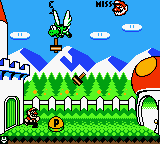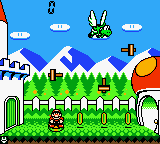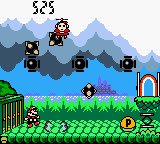This page explains in detail the interactions between the Helmet series and the Mario series.
Game & Watch Gallery 2[]
September 27, 1997

Mario in "Modern" Helmet (played on a Game Boy Color) avoiding hammers, spiked balls and Podoboos.
In "Modern" Helmet the player controls Mario who must avoid falling objects through three different stages. If the player loses at less than 100 points and then hits "Retry", will play as Wario instead. Every game screen features a P-Switch that when stomped makes two or three coins appear for the character to pick up, to get extra points. In the first stage the character must go from a castle to a mushroom-shaped house avoiding the objects tossed by a Koopa Paratroopa, that are mainly hammers, occasionally spiked balls and rarely, only in Hard mode, Podoboos. Getting 500 points makes Toad appear at the exit door and gets the player to the next stage. Stage 2 is a meadow that features a Fly Guy dropping spiked balls. Up to five cannons appear in the air making any spiked balls that fell into them drop faster or get fired off in 45 degree angles. To enter the exit door of the stage there's a trampoline. The stage is beaten by getting 1000 points, and once again Toad appears in the door. The third and final stage takes place in a castle and features three Podoboos bouncing up and down and two Thwomps that occasionally rise to the ceiling and fall to the floor squishing the character. The exit is a pendulum clock reminescent of the Tick Tock Clock from Super Mario 64. At 200, 500 and 700 points the enemy will drop a 1-Up Heart, removing a miss if it's picked. Also occasionally a Star appears in the exit door, providing extra points if picked. The background of the stages is significantly different if the game is played on a Game Boy Color (or Game Boy Advance) rather than on a regular Game Boy or a Super Game Boy. The first two stages feature the classic "eyed hills" from Mario games when played on a regular Game Boy or a Super Game Boy, while if played on a Game Boy Color the second stage features a castle in the background.
License[]
Copyrights for both series are held by Nintendo.










